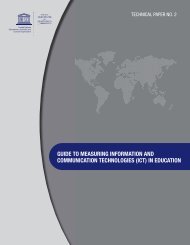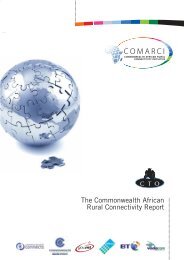Transforming education: the power of ICT policies - Commonwealth ...
Transforming education: the power of ICT policies - Commonwealth ...
Transforming education: the power of ICT policies - Commonwealth ...
You also want an ePaper? Increase the reach of your titles
YUMPU automatically turns print PDFs into web optimized ePapers that Google loves.
expressed concerns that <strong>the</strong> fi gure was so high (Chua, 2009). The fi gure is high when compared to American youths<br />
who spend about 13 hours per week on computer games. The authorities are concerned about this excessive<br />
gaming among students and <strong>the</strong> effects <strong>of</strong> gaming on <strong>the</strong>ir psychological development.<br />
Policy Features<br />
Singapore introduces three successive <strong>ICT</strong> Master Plans for <strong>education</strong> since 1997. This phased approach provides<br />
schools with concrete foci in each Master Plan and encourages <strong>the</strong> schools to make incremental progress building<br />
on <strong>the</strong> foundations laid by <strong>the</strong> preceding Master Plans.<br />
Before <strong>the</strong> conceptualization <strong>of</strong> <strong>the</strong> fi rst <strong>ICT</strong> Master Plan in 1997, <strong>the</strong>re were many <strong>ICT</strong>-based projects. However,<br />
<strong>the</strong>se projects were not nationally driven and started on an ad hoc basis. These projects were mostly exploratory<br />
and schools joined on a voluntary basis. One example is <strong>the</strong> AITP – Accelerated <strong>ICT</strong> Practice for primary schools.<br />
A number <strong>of</strong> primary schools group toge<strong>the</strong>r with <strong>the</strong> support from <strong>the</strong> Ministry <strong>of</strong> Education (MOE) to introduce<br />
<strong>the</strong> use <strong>of</strong> computers in teaching and learning. Similarly, projects were started by a number <strong>of</strong> secondary schools,<br />
and junior colleges (university matriculation colleges) to help students to acquire <strong>ICT</strong> skills and use technology for<br />
teaching and learning (Wong, 1999). The National Computer Board, a government body for promoting <strong>the</strong> use <strong>of</strong><br />
technology for <strong>education</strong>, business and administration was also involved in a number <strong>of</strong> projects for <strong>the</strong> schools.<br />
They supported <strong>the</strong> schools by working with various IT companies to provide <strong>the</strong> technology and skills training.<br />
There were many pockets <strong>of</strong> innovation but <strong>the</strong>re was no synergy among <strong>the</strong> projects, no systematic scaling-up <strong>of</strong><br />
projects and no plans for its sustainability. The Ministry <strong>of</strong> Education felt that <strong>the</strong>re was a need to mount a national<br />
programme to help school operationalize <strong>the</strong> use <strong>of</strong> technology and to get all schools involved ra<strong>the</strong>r than just a<br />
pocketful <strong>of</strong> schools.<br />
In 1997, <strong>the</strong> Prime Minister, Mr Goh Chok Tong announced a vision for Singapore’s <strong>education</strong> system – Thinking<br />
Schools, Learning Nation – this is an important philosophy for <strong>the</strong> country’s <strong>education</strong>al system and until today,<br />
we are referring to this phrase in our <strong>education</strong>al reforms. It is important and should not be removed.. The vision<br />
describes a country with its citizens committed to be lifelong learners and schools to serve as <strong>the</strong> cradle for<br />
promoting this vision through <strong>the</strong>ir thinking students. Schools’ programmes and initiatives shifted to help students<br />
acquire and develop good thinking skills. One <strong>of</strong> <strong>the</strong> initiatives to help support <strong>the</strong> TSLN vision is <strong>the</strong> introduction<br />
<strong>of</strong> <strong>the</strong> fi rst <strong>ICT</strong> Master Plan for Education. The underlying philosophy <strong>of</strong> <strong>the</strong> Master Plan is that “<strong>education</strong> should<br />
continually anticipate <strong>the</strong> future needs <strong>of</strong> society, and work towards fulfi lling those needs.” The skills required for<br />
<strong>the</strong> future will centre on thinking skills, learning skills and communication skills’ (MOE, 2002a).<br />
The First <strong>ICT</strong> Master Plan for Education (MP1: 1997-2002)<br />
Goals<br />
There were four overarching goals in <strong>the</strong> fi rst Master Plan (Teo, 1997):<br />
apple enhance linkages between <strong>the</strong> school and <strong>the</strong> world around it;<br />
apple generate innovative processes in <strong>education</strong>;<br />
apple enhance creative thinking, lifelong learning and social responsibility; and<br />
apple promote administrative and management excellence in <strong>the</strong> <strong>education</strong> system.<br />
Implementation Strategies<br />
To help achieve <strong>the</strong>se goals, four key dimensions were identifi ed:<br />
Case Study: Singapore | 47
















